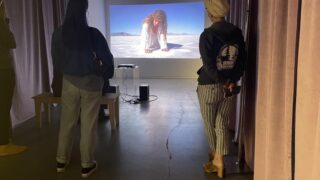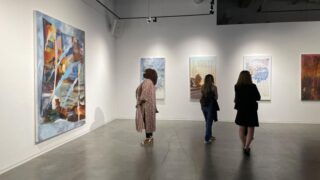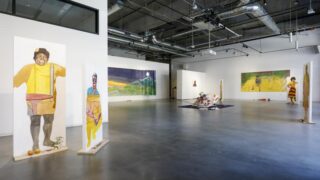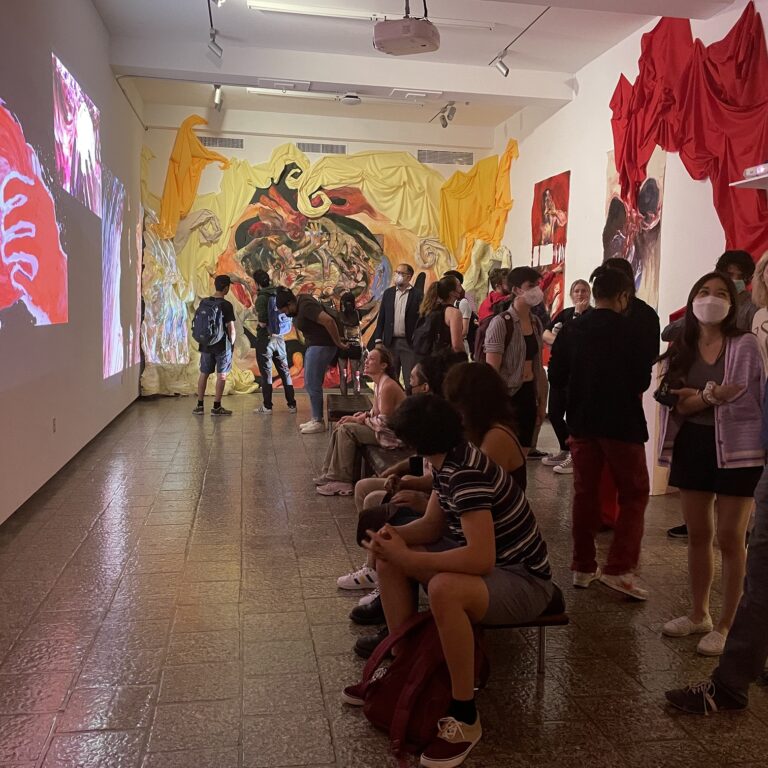Exhibitions
A Professional Gallery Experience
Exhibitions are an exciting part of an art and design education, and as a Roski undergraduate student in art or design, you may apply for independent exhibitions in either the Helen Lindhurst Fine Arts Gallery or the Gayle and Ed Roski Gallery.
USC Roski graduates in the MA Curatorial Practices program present an exhibition or other public component each year. MFA Art candidates present Solo Thesis Exhibitions throughout the spring semester of their second year. All exhibitions and presentations take place in the Roski Graduate Gallery.
MFA Design students present an Annual Industry Night to which they invite professionals in the field, along with their friends and families. The MFA candidates meet with the designers and preview their latest projects.
See past exhibitions
See upcoming exhibitions
→ Are you a current student looking to learn more about applying for an exhibition space? Click here to access our exhibition student resource page, which includes information, documentation, and more.
Annual Student Exhibition
The USC Roski Annual Student Exhibition is a juried show of undergraduate work. Held at the USC Fisher Museum of Art, the exhibition features painting, design, sculpture and intermedia art, and highlights innovative and impactful work by students across majors. Students enrolled in the current year may apply, submitting as many as three works made in a Roski class.
Other Undergraduate Opportunities
Independent Student Exhibitions
New undergraduate student exhibitions open every two weeks in the 1,500-square-foot Helen Lindhurst Fine Arts Gallery, and limited calendar spots are awarded on the merit of a proposal.
Graduate Exhibitions and Public Presentations
As a degree capstone, all Roski MFA Art students mount a thesis exhibition under the guidance of the program director. Your solo exhibition will be mounted in the Graduate Gallery, a well-appointed, 2,000-square-foot space with moveable walls, a lighting grid and a roll-up door for installation of large-scale works. You are also required to submit, according to Roski and Graduate School guidelines, an accompanying written thesis providing a rigorously researched, and theoretically and historically grounded, set of arguments relating to the studio thesis project.
MA Curatorial Practices candidates research and write a thesis and develop a curatorial project with a public interface component as degree capstones. Your curatorial project is developed through the curatorial practicum course series, a three-term laboratory. In it, you will study the history of curating, exhibition making and arts programming, and you will emphasize the presentation of work in a final exhibition or program as well as the creation of an interface, all of which you will present in the Roski Graduate Gallery.
In addition to a written thesis, MFA Design candidates mount a practice component which can include an exhibition, public presentation, community project or proposal for a new course or program. These final projects are often presented in a public Industry Night for professionals, family and friends.
Graduate Open Studios
Before completing a Roski MFA Art, MFA Design or MA, you’ll participate in two open studio events. Winter open studios are timed to coincide with the Frieze Art Fair in Los Angeles, which draws art patrons, curators and writers from around the globe.
Recent Graduate Solo Projects
Recent MFA and MA exhibitions have explored issues of poetic mistranslation, the design user experience, and housing and homeless rights. See more past exhibitions
MFA Thesis Exhibition / Sophia Alana Stevenson
Sophia Alana Stevenson holds a BFA from Watkins College of Art, Design, and Film in Nashville, TN, with a concentration in sculpture. She is currently an MFA candidate at the USC Roski School of Art and Design working in video, performance and sculpture. Stevenson’s thesis exhibition, …a perpetual sunrise, features a body of video installation work that investigates the experiences and perils of closeted queer relationships, connecting historical gay literature, films, and poetry to the present and personal. She also explores the idea of “queer longing,” which comes from self-discovery, reaching for the unattainable, and grappling with desire. Stevenson’s art has been included in exhibitions including The Skin I Live In at Lyles & King in New York (NY).

MFA Thesis Exhibition / Jessica Taylor Bellamy
Los Angeles-based artist Jessica Taylor Bellamy explores the tension of living at the edge of a precarious paradise. Primarily working with oil painting, Bellamy also incorporates screen printing, animation, and video installation into her practice. Her work functions as collages that intend to deconstruct idealist narratives by exploring the political, social, and ecological implications of a false promise of paradise and false notions of progress. Through a critical and loving approach, Bellamy examines the phenomenological experience of the California landscape and proposes that we reimagine our relationship to the environment and examine the social structures that strain it. Bellamy creates layered compositions of overlapping and intersecting representations of culture, history, plant species, and sun phases that result in dream-like narratives or windows that give form and visibility to unseen or alternative possibilities.
This exhibition is curated in collaboration with Lauren Guilford, writer, curator, and art historian based in Los Angeles. She is a candidate in the USC Roski Masters in Curatorial Practices and the Public Sphere Program.

MFA Thesis Exhibition / José Guadalupe Sánchez III
When my brothers and I were young, our mother would have us accompany each other wherever we went. This request was often placed on my older brothers as I am the youngest. When they resisted, as teens do, asking “why do I have to go?!” our mother would respond exclaiming “Para acompañar!”
In this context, loosely translated, para acompañar means: for the purpose of accompaniment. To accompany, in a world structured for individualism is a political and philosophical stance. This stance is where this exhibition finds its traction. Through paintings, installation, video, and performance Sanchez engages us directly in the gallery space to explore how we are accompanied by many things at every moment including spirits, objects, places, and values. The work questions the legitimacy of arbitrary distinctions such as life/death, alone/together, and past/present and explores how we may carry these ideas with us. Para Acompañar calls for a self-reflexive conversation between the artist and viewers, asking us to think together about how the lenses through which we experience the world accompany and influence our judgment of the world. Sanchez offers not a space of passive viewership but an invitation to participate, to be vulnerable, to give and receive.

